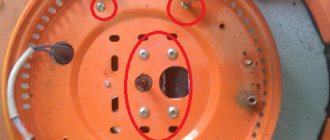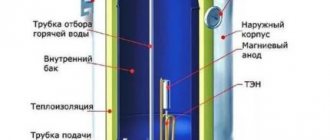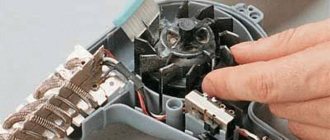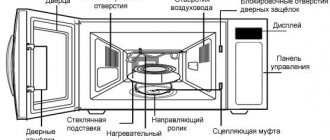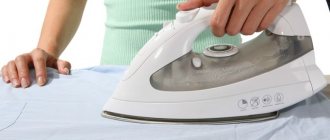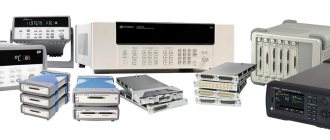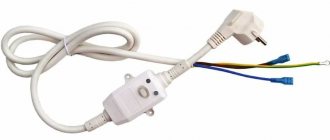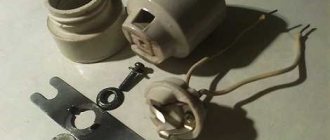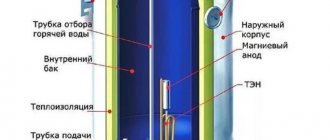Regardless of the brand of water heater and its cost, breakdowns will occur sooner or later. Most of them have nothing to do with the operating features, but it would be stupid to exclude the possibility of a malfunction due to the fault of the user himself.
Each water heater, due to its design features, has certain breakdowns, but most of them can be prevented or corrected independently. The main thing is to follow clear instructions and maintain maximum safety.
Diagnostics: how to recognize a breakdown yourself
The first step is to make sure that the boiler is not heating water due to internal failure. To do this, rule out other possible problems:
- Check for electricity in the house.
- Look at the position of the circuit breaker to which the device is connected. The water heater consumes a lot of energy, which may cause the network overload protection to trip.
- Inspect the outlet and electrical plug, which may have burned out due to high voltage.
If the problem is electrical, ask a specialist to check the condition of the wiring, eliminate the faults and redistribute the load on the network. Is your home electrical supply ok? Then check out the list of warning signs below.
The boiler body is electrocuted
If you accidentally come into contact with the heater, you may notice how it transmits a discharge. It may not shock much, but it is quite unpleasant. One reason is the direct contact of electricity with water. This happens due to a crack in the heating element, which is caused by accumulated scale. When the boiler is connected to the network, not only its body, but also the flowing water can carry a charge.
If the body of the water heater is electrocuted, then it is necessary to check the heating element
In this case, it is necessary not only to check the heating element and, if necessary, replace it, but also to ensure proper grounding of the electrical appliance. If this causes difficulties, then it is better to entrust the repair to a specialist.
It is extremely unsafe to use a hot water heater. Sooner or later this will provoke a global breakdown or cause health problems.
Types of breakdowns and causes
The boiler does not heat the water, the lamp is on
If you notice that the boiler has stopped coping with its direct responsibilities, the problem may lie in a faulty thermostat, which affects the operation of the heating element, or in the heating element itself. In the second case, the problem is most likely scale: it covers the tubular electric heater and reduces its efficiency. This may also be indicated by the fact that the device takes a long time to turn on or turns off frequently.
The situation will be saved by replacing the part or thoroughly descaling. If filters are not installed in the house, the heating element should be cleaned before the first warning signs appear - preferably once a year. We advise you to seek help from a qualified technician: in order to clean the element, you need to disassemble the device - this requires plumbing skills.
How to avoid this?
Don't want to clean your water heater every year? Be proactive: install water filters!
- If you are concerned about the quality of the water in general, install a main filter. It cuts directly into the water supply and household appliances, including the water heater, use the already filtered water. This solves the scale problem at its root. A mainline cleaning system is a good investment for several other reasons:
- Purifies all water in an apartment or house.
- Productivity reaches 50 l/m.
- The filter properties vary depending on the installed cartridge. You can buy replacement modules for mechanical, ionic, sorption purification or special-purpose cartridges and choose the type of filtration that is right for you.
- With proper use, the filter will last more than 10 years. Just don't forget to change the cartridges!
- Install a softener or appliance pre-filter if the water quality seems acceptable and you simply want to save time and money on boiler maintenance. These devices are designed for technical filtration of water entering a specific household appliance:
- They consist of a sealed body and a special backfill, which, when dissolved, removes hardness salts and heavy metal impurities from the liquid. The content of the filter must be updated promptly.
- Not as effective as main filters, but they extend the life of a water heater or washing machine by 3–5 years.
Source
How does a boiler work?
There are storage and instantaneous water heaters. The first ones consist of a large container in which a heating element is installed. Water enters the device and is stored there at a certain temperature.
Using a temperature sensor connected to a thermostat, the temperature is maintained at the set level. To prevent loss of thermal energy, the body of the storage tank is covered with a layer of insulation.
Before starting to operate the boiler, you should study its structure, technical characteristics and manufacturer’s operating recommendations in order to prevent breakdowns
Flow models work differently. They also have a housing and a heating element, but do not store water inside. The device turns on the moment water flows through its body.
The liquid quickly heats up to the desired temperature. These devices are more powerful than storage models; they consume more electricity. But their sizes are compact and installation is a little easier.
And yet, in everyday life, a storage version of the water heater is more often used. Failures of different types of devices are similar, and they are eliminated using approximately the same means.
To automate the operation of the water heater, use a thermostat. This element receives data about the current state using a temperature sensor. It turns the heating element on and off based on incoming information.
This helps not only maintain the optimal temperature inside the drive, but also makes it possible to save energy. The device also prevents dangerous overheating of water, which could cause a serious accident.
If the boiler is leaking in the area where the water pipes are connected, incorrect installation of the device is most likely to blame, and the connections will need to be resealed
Hot water is gradually withdrawn from the tank and replaced by cold streams from the water supply. At this moment the heating element usually turns on. If the hot water in the boiler has not been used for a long time, it may cool down. Too low a temperature also gives a signal to turn on the heating element.
An article dedicated to the design differences and technical characteristics of equipment models popular among consumers will introduce you to the features of choosing electric water heaters.
What to do to correct the situation
If the boiler does not heat, the light does not light, follow these steps:
- Check whether its plug is plugged into the outlet.
- Press down on the plug to make sure the connection is secure.
- Plug in another household appliance (table lamp, hair dryer, mixer) to check the power supply.
- Press the safety device off button, then the power button. The indicator on the RCD body should light up.
- Turn the thermostat knob to the maximum setting.
- If you have skills in servicing electrical appliances, check the thermal cut-off: disconnect the heater from the mains, remove the protective cover, press the thermal protection button on the emergency thermostat, and plug it in.
If, after all the actions taken, the boiler still does not heat, the light does not light , or the automation still constantly works, call a water heater repair specialist from the service center.
Types of heaters according to the heating element used
There are boilers with “dry” and “wet” heating elements. In the first version, the heating element is placed in a special flask, and in the second it is in direct contact with water. Both models have certain advantages.
In terms of boiler repair, it is believed that it is much easier to replace a “dry” heating element than a “wet” one, since to do this you just need to remove it from the flask and put a new element there.
In the case of a “wet” heating element, you will first have to completely drain the water from the container, and only then replace it. Typically, “dry” heating elements are less efficient than the “wet” version, so not one, but two such heating elements are most often installed in a boiler.
A “dry” heating element is not the same, but replacing it is somewhat easier, since you do not need to drain the water from the tank
Due to the nature of their operation, “dry” heating elements burn out more often and need to be replaced, therefore models with “wet” heating elements are more popular. It is worth noting that you can also find modern boilers with very reliable “dry” heating elements of the latest generation, but the cost of such devices may be too high.
But the type of heating element does not affect the amount of scale formed during operation. But if with a “wet” element scale deposits directly on the surface, then with a “dry” heating element the deposits accumulate on the protective flask.
How to avoid repeated breakdowns
After the technician finds out why the boiler stopped heating water and repairs it, follow these recommendations:
- Every year, order cleaning of the tank and heating element from the service center and replacement of the magnesium anode. Due to poor quality water, the metal becomes overgrown with scale, and the anode dissolves.
- If the water heater is equipped with an electronic control module, and periodic power surges are observed in the electrical network, use a voltage stabilizer or relay (“barrier”).
- Set the economical water heating mode to +55-60°C. Some manufacturers mark it with the letter “E”.
- If there is strong water pressure in the main, install a pressure reducer so that it does not burst the internal tank.
If the boiler does not heat, the light does not light up, and you cannot determine the malfunction,
call our service center!
Write a review Your Name:
Your feedback:
Attention: HTML is not supported! Use plain text.
Source
Changing the heating element in the boiler
You can do the same with the heating element: immerse it in a solution of citric acid for a day. If the situation is critical, then it is better to replace the part. After the heater and the walls of the tank have been cleaned, you need to install all the parts in place, pour water, and connect electricity. Be extremely careful when connecting the water heater to the power supply. Before starting, do not forget to check the water heater for leaks. Fill it with water and wait half an hour - if no water leaks out, you can turn it on.
Important! If you have forgotten how the device was connected, the diagram shown on the thermostat can serve as a hint. You can also use your smartphone camera before disconnecting
Causes of breakdowns of storage water heaters
If your boiler has stopped heating water, the very first thing you need to do is figure out whether power is being supplied to the device. It is necessary to check whether there is a contact in the cable connecting the electric storage water heater
with a socket or electrical panel, depending on how your connection is made.
You can test the wire using an indicator screwdriver or tester by ringing its ends. The indicator should light up at “phase”, at “zero” and “ground”; in a working wire there is no signal. Cause
The lack of power may also lie in the outlet itself; this can be checked by connecting any other working device to it.
If it is faulty, most likely the outlet parameters do not match the power of the device. It is necessary to check whether the fuse is blown; this can happen when several high-power devices are connected at the same time. Then you need to check the contact of the cable with the terminals on the water heater; after a certain time, it may weaken or the connection may burn out. If there is no electrical power supply to the device, the indicator will not light up
Everything is fine with the power supply to the unit, but the electric storage water heater does not heat up and light does not light up? Cause
hides in the malfunction of the internal components of the water heater. To detect and correct the problem, turn off the heater and drain the water from it. Then the housing casing is removed from the boiler, and parts are taken out for inspection.
When a storage electric water heater
stopped
heating
the water, you need to check the serviceability of the thermostat. To monitor its performance, a tester is used; its contacts are connected to the contacts of the thermostat. If the device shows voltage, to restart you need to press the thermostat start button.
Testing the performance of the thermostat
Turning on happened, which means the device turned off due to the reason for the thermal protection tripping. Why does the thermal protection trigger in the unit? After heating the water above ninety degrees, the protection turns off the device. This can also happen due to the presence of a thick layer of scale on the heating element; to eliminate the problem, you need to clean the scale on the tubular heater.
If the thermostat does not turn on after pressing the thermal protection button, the thermostat is most likely faulty and needs to be replaced with a new one.
In the absence of heating of the boiler, the breakdown of the heater often becomes the cause. The average operating life of a tubular heater will be approximately four years. If you do not change the anode in time, this period can be noticeably reduced.
The serviceability of the tubular heater is examined by a tester, the resistance at the contacts is measured, if there is no resistance, the tubular heater is faulty. When the boiler seems to be working, light is on, but slowly and weakly heats the water, it is necessary to clean the TENA and the tank from scale.
Checking the Tubular Heater
Moreover, a breakdown occurs on the housing, which can also be detected using a tester. When a breakdown occurs, the RCD is triggered. In both cases, it is impossible to repair the tubular heater; it must be replaced. When purchasing, a component with similar parameters is selected.
How to care for your water heater
The quality of main water allows for an increased content of hardness salts. A concentration of magnesium and calcium salts that is harmless to humans precipitates on the surface of the heating element. The same layer of salts on the inner surface of the tank is not dangerous. It increases the protective layer and becomes additional insulation. And the heating element must be cleaned annually, since the sediment does not conduct heat, the element overheats and fails. In an acidic solution of acetic or citric acid, the precipitate is destroyed and the element becomes pure.
As a preventive against scale, you can use preliminary softening of water before supplying it to the water heater. There are special water purification filters for this. Be sure to install a filter on the water supply line to remove suspended substances from the water and direct them into the sump.
Why does the flow-type heater not work?
If the instantaneous water heater does not work, the first thing you need to do is also check the power cord. Flowers generally have higher power than storage devices.
For continuous operation, the connection must be made with a cable with a cross-section of at least 4 square meters. mm, with a power of 5 kW a separate 30 A circuit breaker is connected, from 7 kW - 40 A. Otherwise, your EVN will work for a short time. It is necessary to check the serviceability of the Residual Current Device by pressing the “Test” button on it; the serviceable Residual Current Device should turn off. It will be useful to check the strength of the connection of the wires on the shield.
A malfunction of the tubular heater in the flow duct very often occurs due to low supply water pressure, when the pressure meter does not have time to operate, the heating element burns. Also, if the design of the EWH is designed in the same way that the tubular heater is in direct contact with water, and not in a protective flask, salts may corrode the surface of the TENA.
Tubular instantaneous boiler heater
Poor installation of the device also turns out to be the basis for burnout; it must be carried out strictly in accordance with the manufacturer’s advice, since changing the installation angle leads to the fact that the thermostat probe does not come into contact with the spiral, and it burns out. Under any circumstances, the heater itself is very often changed, since the cost of a tubular heater is not significantly less than the cost of an EWH.
A breakdown of the boiler pressure sensor is often considered to be the reason why your device does not turn on. An important element of this sensor is a rubber membrane fabric, which, under the pressure of passing water, turns on a microswitch. During operation, it can stretch and tear due to the side effects of salts in the water. In this case, it needs to be replaced; it is better to buy a silicone one, it will last longer.
The temperature sensor can also cause a breakdown. To determine its performance, call its contacts; if there is no signal, the meter is faulty and cannot be repaired.
Water temperature sensor
The EWH may also not work due to the fact that the contacts at the connecting points of the wires with the terminals very often burn out on flow machines. Sometimes you need to check the stability of connections and tighten loose contacts.
Source
Disassembling the water heater
It is recommended to follow one simple rule: if the boiler shows the slightest signs of malfunction, it is better to perform a complete disassembly and a comprehensive inspection. To do this, you need to drain the water through the cold water supply pipe, opening the “hot” tap to suck in air. With proper hydraulic piping of the boiler, this possibility is always provided. Unpack the connection fittings and loosen the anchor nuts to lift the tank up and away from the wall.
Classically shaped water heaters are serviced from the bottom. First you need to remove the protective cover of the control unit by unscrewing several screws and unfastening the latches. The task is quite delicate: not only can some fastening screws be hidden under stickers, a regulator knob or a nameplate, but also the fragile clips are located far from obvious places.
Inside the block there is electrical wiring: the red and blue wires, terminated with terminals, are removed from the contacts of the heating element, the yellow-green one is disconnected by twisting the grounding nut onto the housing. Next, we disconnect the wires of the thermostat and temperature controller, remove the thermal conductor, which is sometimes made in the form of an ordinary single-wire copper wire.
Having separated the tank and the electrical part, we tighten the nuts securing the technical flange. After removing them, you need to put some effort and tear the flange off the neck; it can become completely stuck. The tank must be in an inverted position to prevent any remaining water from leaking onto the floor.
When the flange, along with the devices attached to it, is removed, you will be able to clearly assess the quality of tap water. Scrape off the bulk of the dirt from the functional elements directly into the tank and set it aside for the time being; we’ll return to the heating element and anode a little later.
For stylish and modern tanks, the lower part of the body plays the role of a protective casing. Indication and control panels and a built-in thermometer are auxiliary equipment that is not directly related to operation; if they fail, they are replaced modularly.
Causes of storage boiler malfunctions
If your water heater stops heating water, the very first thing you need to do is figure out whether power is being supplied to the unit. Check if there is a contact in the cable connecting the boiler to the socket or electrical panel, depending on how you made the connection.
You can test the cable using an indicator screwdriver or tester by ringing its ends. The indicator should light up on “phase”, on “zero” and “ground”; in a working wire there is no signal. The reason for the lack of power may lie in the outlet itself; this can be checked by connecting any other working device to it.
If it is faulty, most likely the outlet parameters do not match the power of the device. Check if the fuse is blown; this can happen when several high-power devices are connected at the same time. Then check the contact of the cable with the terminals on the water heater; it may weaken over time, or the connection may burn out. If there is no power supply to the unit, the indicator will not light up.
Is everything in order with the power supply to the unit, but the storage boiler does not heat up and the indicator light does not light up? The reason lies in the breakdown of the internal elements of the boiler. To identify and eliminate the breakdown, turn off the power to the heater and drain the water from it. Then the housing casing is removed from the water heater, and parts are removed for inspection.
When the boiler stops heating water, you should check the functionality of the thermostat. To check its performance, a tester is used; its contacts are connected to the contacts of the thermostat. If the device shows voltage, to restart you need to press the thermostat start button.
Testing the performance of the thermostat
The switching on occurred, which means that the unit turned off due to the thermal protection tripping. Why does the thermal protection trigger in the unit? After heating the water above ninety degrees, the protection turns off the device. This can also happen due to the presence of a thick layer of scale on the heating element; to eliminate the problem, you need to clean the deposit on the heating element.
If the thermostat does not turn on after pressing the thermal protection button, the thermostat is most likely faulty and should be replaced with a new one.
If the water heater does not heat up, a common cause is a malfunction of the heating element. The average service life of a heating element is about four years. If you do not change the anode in a timely manner, this period can be significantly reduced.
The serviceability of the heating element is checked with a tester, the resistance at the contacts is measured, if there is no resistance, the heating element is faulty. When the water heater seems to be working, the indicator light is on, but it heats the water slowly and weakly; it is necessary to clean the heating element and the tank from scale.
Checking the heating element
In addition, a breakdown occurs on the housing, which can also be detected using a tester. In the event of a breakdown, a protective shutdown device is triggered. In both cases, it is impossible to repair the heating element; it must be replaced. When purchasing, an item with similar parameters is selected.
The water temperature does not correspond to the specified parameters
Significant deviation of water temperature from the specified parameters
The problem arises in two cases, when the water from the heater is either too hot (literally boiling water) at minimum heating values, or cold and heating does not occur at all. There is also an intermediate malfunction, when the maximum heater values are set, and the water is slightly warm. All problems deserve attention, the causes of which can be quite numerous.
So, let's consider a situation where the water heater, at maximum values on the relay, produces only warm water in the tap, which is preceded by the following possible problems:
- The heating element is covered with scale, it consumes more energy on heating, while the efficiency is at a minimum.
- There are problems in the central board that are blocking the relay signal to the desired temperature.
If the water heater visually turns on and supposedly works, but in fact only produces cold water, then the reasons may be similar to those stated above. When the temperature of the water is exceeded, the problem lies in a malfunction of the thermostat or thermostat, which is responsible for fixing the heating parameters set by a person and maintaining this temperature inside the water heater.
If the problem is related to temperature mismatch, you need to perform the following sequence of actions:
- Check the heating element for contamination and proper operation : disconnect the boiler from the mains, allow the water to cool and drain it as much as possible, then remove the protective cover at the bottom, open the valve and carefully remove the heating element. Using a multimeter, check the functionality of the element, which is fixed in the range of values 0.68-0.37 Ohm. If there is a break, the indicators will be unstable and will tend to infinity. If there is scale, it can be removed by soaking it in a special acid solution, which can be bought at any household store. Apple cider vinegar is an alternative.
- Take out the thermostat and evaluate its performance : disconnect the boiler from the network, drain the water, remove it from the wall. Find the thermostat (you can see in the instructions what it looks like and where it is located for a specific model) and press the safety button all the way. Next, the metal tube needs to be slightly heated with a lighter. If the thermostat is working, then when it heats up it will react and return the button to its original position. If this does not happen, then you should completely dismantle and replace the element with a new one.
Similarly, you should go through all available contacts with a multimeter, since there is a possibility of a break, which provokes a lack of proper operation.
Expert opinion
Grebnev Vadim Savelievich
Heating system installer
Before draining the water, you need to let it cool. If you don’t have time to wait, then the following trick will do: open the hot water tap to maximum, unplug the boiler. After about 5-7 minutes, the water in the tank will become slightly warm, which will facilitate the process of draining it.
How much does professional repair cost?
If you contact Neva-Service St. Petersburg, boiler restoration services will be inexpensive.
| Service | Cost, from | ||
| When calling | Direct call −5% | For pensioners and social categories −10% | |
| Replacing the power cord | 500 rub. | 475 rub. | 450 rub. |
| Replacing a button | 900 rub. | 855 rub. | 810 rub. |
| Replacement of RCD | 900 rub. | 855 rub. | 810 rub. |
| Restoring wiring | 900 rub. | 855 rub. | 810 rub. |
| Finding and fixing leaks | 900 rub. | 855 rub. | 810 rub. |
| Replacement of safety valve | 900 rub. | 855 rub. | 810 rub. |
| Cleaning and flushing the tank | 1500 rub. | 1425 rub. | 1350 rub. |
| Replacing one heating element | 1500 rub. | 1425 rub. | 1350 rub. |
| Replacement of subsequent heating elements | 1000 rub. | 950 rub. | 900 rub. |
| Replacing the magnesium anode | 1500 rub. | 1425 rub. | 1350 rub. |
| Replacing the thermal fuse | 1500 rub. | 1425 rub. | 1350 rub. |
| Replacing the thermostat | 1500 rub. | 1425 rub. | 1350 rub. |
Device repair
Start the repair by finding the cause of the device malfunction. Most often, the boiler refuses to work due to a power outage or damage to the electrical circuit. If there is no voltage at the outlet, fix it.
- water is not collected;
- RCD is triggered;
- no heating occurs;
- insufficient degree of heating;
- the appearance of leaks.
The reason may be a broken heating element.
Fault codes
Some water heaters have a panel where the reason for failure is displayed in the form of a code or word. Code E1 (vacuum) means that the cold water supply has been stopped when the heating element is on. You should turn off the heating and wait until the tank is completely filled. Only after this can you connect the device to the network.
Code E2 (Sensor) indicates a failure of the temperature sensor. It is recommended to reboot the device by briefly turning it off and on.
E3 (Over Heat) means that the ambient temperature has risen above the critical value of 95 degrees. The thermostat button must be pressed.
Leak in tank
Leaks may occur at the flange attachment point or at the bottom of the tank. The reason lies in installation errors, wear of soldered seams, and improper maintenance. In the absence of grounding, premature corrosion also begins.
The cause of a leak from below may be a worn gasket on the flange. To fix the problem, before disassembling the device, you need to turn it off, disassemble the flange connection and replace the deformed part. Then turn on the boiler and see how it works.
If the device is leaking at the seams, it is easier to replace the model, since it is unlikely that you will be able to repair the seams yourself at home without deforming the case. A stainless steel tank can be boiled. If there is a protective inner coating of glass enamel, welding cannot be used, since the surface layer will become unusable.
Scale
Tap water has high hardness; when heated, salt deposits are deposited on the boiler body and internal parts. What does this mean:
- an increase in temperature pressure, which can trigger the RCD;
- underheating;
- breakdown.
It is recommended to carry out preventative descaling. The process is carried out in several stages. In order, we disconnect the boiler from the network, turn off the water supply, empty the tank, disconnect the wires and dismantle the heating element.
Then rinse the electric heater with warm water. We remove salt deposits using special descaling compounds or using home remedies by adding a bottle of vinegar to the water. It is recommended to soak the heating element in this composition until the salts dissolve.
At the final stage, rinse all parts with clean water, dry them and assemble the water heater.
Failure of the heating element
Main symptoms of malfunctions
- the water does not heat up;
- the RCD is triggered and the device is turned off;
- insufficient heating of the working environment;
- the power indicator does not light up;
- noise inside the structure;
- At the boiler outlet, muddy water with an unpleasant odor is drained;
- knocks out the machine gun.
The appearance of the heater does not always allow one to detect a defect if the shell is not damaged. In this case, use the tester:
- zero – short circuit;
- infinity is a break in the spiral.
- long service life;
- overheating of the heating element due to lack of liquid in the boiler;
- easy operation of a filled water heater for a long time;
- damaged thermostat;
- voltage drops in the network.
The reason may be scale and wear of the anode. Sometimes it is enough to turn the boiler on and off several times for the device to work.
How to change the heating element
Follow the given algorithm:
- Unplug the water heater.
- Close the shut-off valve at the inlet to the device.
- Drain the water from the boiler through the drain pipe using a hose.
- Disconnect the device from the mixer.
- Now remove the heater and turn it over.
- Unscrew the nuts on the flange to remove the bottom cover.
- Disconnect the wires from the heating element.
- Pull out the thermostat and temperature sensor.
- Dismantle the non-working heating element, if necessary, lightly clean it with a screwdriver.
Now all that remains is to replace the heating element and perform the operations in reverse order.
Can I fix the problem myself?
Troubleshooting a water heater requires the user to have experience working with water heating equipment. This will help him not to confuse anything and actions to correct breakdowns will not cause even bigger problems.
If there is no such experience, then when dismantling various parts of the water heater, disassembling its parts and components, it is better to invite a specialist involved in the repair of devices of this class and brand. The measures are related to the fact that different models of devices from different manufacturers necessarily have significant design and functional features and their own specific functioning. This applies to both the appearance of the device and the features of the configuration, the layout of its internal parts and elements.
For example, one well-known company decided to equip its water heaters with connecting elements in the form of self-clamping clamps, while another uses nuts to connect pipes, and the use of anything else, in this case, will be useless.
In heating devices from other companies, the spiral of the water heating element is placed in a hole with a diameter of 65 mm. To attach it to the tank, special tools are needed, and the screwed-in bolts are so tightly connected to the nuts that it is simply impossible to unscrew them even if you try. As a result, when something in the device fails, it will not be possible to quickly open its case. In addition, all fastening parts, and there may be more than 12 of them, will have to be removed with a grinder, and the likelihood that by removing the bolts, you can also remove part of the body at the same time is very high. In addition, a boiler is an electrical device, and in order to work with it, you need to know which wire should be connected to which element. Not knowing and not following safety precautions when working with electrical devices can lead to dangerous consequences, the most harmless of which will be a short circuit in the electrical wiring.
If there are interruptions in the operation of the boiler, you cannot do without contacting specialists because difficulties are caused not only by the breakdown of parts of the device, but also by external factors that are in no way dependent on either the user or the device that he is trying to fix on his own.
However, it is necessary to carry out preventive maintenance of the device from time to time: change filters, inspect the internal tank for leaks and possible damage, check the integrity of the electrical wiring, at the slightest suspicion that the device is not working correctly. In the event of a breakdown, contact the service center to troubleshoot. Then the water heater will last a long time and it will be safe to use.
Weakness of the non-return safety valve
Water leakage through the valve drain pipe can be considered normal if a liter jar is drawn drop by drop from it over the course of a day. This is the excess formed when pressure increases from heating. But sometimes it is impossible to determine the amount of liquid flowing out, since it goes down the drain hose into the sewer. If the boiler empties unusually quickly, you may suspect a weak valve. In this case, you will have to install a new part, and in general it is recommended to change this important unit annually.
Water drips from the valve - this is normal.
It is forbidden to empty the boiler through the safety valve opening! Scale and sediment can clog the drainage pores and the mechanism will stop functioning.
- No matter how well the water heater is thermally insulated, heat loss cannot be avoided. So you shouldn't set the temperature regulator to maximum. If the water consumption is moderate, it is better to heat it to a medium temperature so that dilution is not required. Strong heating is desirable at a time when you need to take a shower and you will need to draw a lot of water. Lower temperature means less scale.
- If no one will be home for several days, the water heater should be turned off, but left full. But night shutdowns will not help save energy and will even lead to accelerated wear and breakdown of electronics, which are often forced to experience overloads.
- After a long period of inactivity, the musty water must be drained, the boiler must be rinsed and refilled. Warm up at maximum mode for two hours, this will help get rid of unpleasant odors and bacteria. When there is no need to use the boiler for a long time, for example, in winter at the dacha, it is emptied, dried well and kept warm.
- A useful element such as a magnesium anode will help reduce the formation of scale on the walls of the boiler. It dissolves over time and should be replaced about once a year. But this is a general recommendation, and in each specific case you need to think about whether to interfere with the operation of the equipment. The level of hardness and impurities in the water is different everywhere, but if the unit begins to crackle and heats up more slowly, it would be a good idea to disassemble the structure and inspect it from the inside.
Anode for water heater
- To soften the water, you can install a filter at the inlet of the boiler, the cartridge of which is filled with a special resin. This substance displaces magnesium and calcium ions, and sodium ions appear in their place. Another way to reduce water hardness is to install a hydromagnetic system. The magnet crystallizes the salts, turning them into sludge, which are then retained by the filter.
A properly installed and properly operated boiler can last up to 15 years. Its performance is influenced by various factors: from water parameters to the quality level of parts and components. In diagnostics and repairs, the “random” method should not be used; the main rule is to follow the requirements of the instructions.
Storage tanks capable of heating water to a certain temperature (in common parlance - water heaters or boilers) are most often installed in those rooms where there is no centralized supply of hot water, or there is a high probability of its shutdown. This device has not lost its relevance from ancient times to the present day. Thus, the ancient Greek mechanic Heron of Alexandria (second half of the 1st century AD) is rightfully considered the inventor of the boiler. The unit he created heated cold water with steam. Then they forgot about it, and therefore at the end of the 17th - beginning of the 18th centuries they were forced to reinvent the device. But, like any other household electrical appliance, even an advanced water heater can break down as a result of exposure to internal or external factors, as well as due to simple wear and tear of parts. All the reasons why hot water does not come from the boiler, as well as ways to eliminate them, will be described in this material.
How to troubleshoot
If the cause of the leak is a faulty valve, then it is replaced with a working part adjusted to the same operating pressure. When replacing, or better yet, while installing a water heater, try not to use cheap Chinese products. Remember that the safety of your family directly depends on the valve. Good Italian safety valves with the same non-separable design, although they cost several times more, are purchased once. As practice shows, there are no problems with them in the future. Connect a flexible transparent hose to the drain outlet of the device. This will help you visually evaluate the performance of the part. Lead the end of the hose into the sewer or a suitable container.
Leaking when the boiler is off
Let's simulate the following situation: the water heater is disconnected from the network, the water supply from the water supply is turned on (the tap on the pressure line is open). Water is flowing from the boiler drain hole. The cause of this phenomenon may be either a malfunction of the safety valve or increased pressure in the line.
To find the cause of a leaking safety valve, you need to know the water pressure in the water supply
To determine the culprit of the leak, you need to measure the cold water pressure in the water supply. The fact is that if the main pressure exceeds the accepted SNiP, the valve will open and perform its functions of discharging excess water into the sewer. Most water heater safety valves that manufacturers equip their products with are set to a pressure of 6 to 8 atmospheres. The maximum pressure allowed by SNiP in main water pipelines should not exceed 6 atmospheres. In fact, it often happens that actual indicators exceed standard values by 1 - 2 atmospheres. Naturally, the safety mechanism will work.
The second cause of leaks may be the valve itself. Wear of its plate or seat, weakening of the spring - these are the factors that can lead to leaks. Cheap Chinese products are often susceptible to such malfunctions.
The possibility of particles of scale or debris getting under the locking mechanism plate, which can happen during an emergency pressure release or after draining water from the boiler during maintenance or repair work, cannot be discounted.
Replacing the heating element
The heating element is the most vulnerable component of all Thermex water heaters. Four signs can indicate that it is out of order: the water heats up intermittently, the automation on the electrical panel breaks down, the water generates an electric current, and the RCD regularly trips for no reason. cannot be repaired - if malfunctions occur, it should be completely replaced.
The work is performed according to the following scheme:
- Turn off the power to the water heater and shut off the water supply to the tank.
- Using a hose connected to the drain pipe, drain all remaining water from the storage tank.
- Disconnect the hot water outlet pipe.
- Remove the device from the wall and turn it upside down. Unscrew the screws securing the bottom cover and remove it.
- Disconnect the wires connected to the heating element.
Carefully remove the temperature sensor and thermostat. Remove the deformed heating element: unscrew the nuts that secure the heating element flange, and then remove the element from the tank
If the heater is covered with deposits and scale, carefully clean it with a screwdriver. Service hatches
Service hatches
- Install a new heating element. Secure its flanges with screws. Connect the temperature sensor and thermostat.
- Reassemble and reconnect the water heater.
Ways to solve problems with equipment
During the operation of instantaneous and storage water heaters, certain problems may arise. Most often this is the appearance of an unpleasant odor and mold flowing from the tap along with warm water.
This situation occurs when the heating temperature is set to 40 degrees or the device has not been used for a long time. These are favorable conditions for the development and reproduction of mold and fungi.
To eliminate this problem and not set the maximum heating, you can select the economy mode, if one is provided for a particular model. In the eco mode settings, the limit water heating temperature is set at 50-55 degrees.
It is important to use the correct boiler connection diagram recommended by the manufacturer
Secondly, you cannot connect to a hot water pipeline. Depending on the technical characteristics of the device, they are designed to work with water whose temperature ranges from 2 to 30 degrees.
This is the average range of acceptable values. A specific model may have its own limit values for the temperature of running water, for example, from 5 to 20 degrees.
The third problem is when warm water stops flowing while the instantaneous water heater is running. One of the reasons is problems with incoming water pressure.
Some models require a special low-pressure mixer to operate. If it does not correspond to the technical capabilities of the device, the shutdown mechanism is triggered. The heater can resume operation only after the pressure normalizes.
Another reason is if the water supply through the water supply is cut off. It's not difficult to fix this; you just need to restart the supply.
Fourthly, the water may be running too hot. This problem in models with an automatic temperature control system indicates its breakdown and requires an urgent call to a specialist. For flow-through devices, it is necessary to increase the water flow at the inlet or clean the supply pipes.
If the owner values the warranty service of an expensive device, then he will have to call a specialist to eliminate any malfunction and perform annual maintenance.
The fifth problem is too cold water, which does not satisfy the wishes of the water heater owner. In this case, the thermostat of storage units is likely to break down.
It would be a good idea to check the set temperature, because one of the family members may have changed the minimum water heating temperature.
For flow-through devices, this problem may indicate problems with the power supply. The second option is to increase the heating power.
After the service life specified by the manufacturer has expired, you should not continue to use the equipment. It needs to be dismantled and disposed of.
If this is an electric model, then it is better to cut off the wire connected to the network. This measure will protect against accidental use of the device by third parties.
